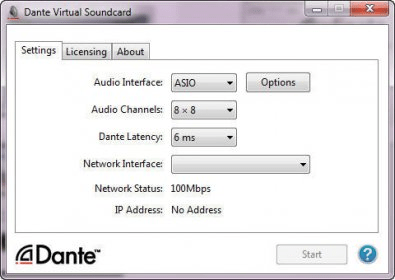

It can also establish audio connections between multiple audio applications on the same computer. Further more, it is capable of aggregating all USB/Firewire interfaces connected to a computer and make all their ins and outs accessible on the entire Dante network in addition to the "regular" Dante channels it also provides.

It just works.ĭante Via is similar to DVS, however, it is capable of providing Dante-PTP-clocking for an entire network.

In my setup, there are over 150 audio channels constantly running between multiple devices and booths in the background at all times! I don't even think about it. No issues at all even when streaming several HD videos on youtube simultaneously while doing a large audio mix over the network. My internet router is also connected (DHCP server). In my config, I have a digital console (Ymaha DM1000), a computer fitted with a 128-in/out-channel Dante PCIe card, a Dante-enabled converter (Ferrofish A32 Dante) and a laptop running DVS connected via 2 Cisco SG200-08 manageable gigabit switches via cat6a cables. For smaller networks (below 25 Dante peers) it is not required to configure QoS, however QoS will ensure that IP audio packets and especially PTP-based Dante clocking will be prioritized. It is important to turn off any "green ethernet" and energy saving functionality which could lead to unwanted data throttling and thus may risk audio drop-outs. Regarding switches, you'll need a standard manageable gigabit switch. However, you can connect multiple computers running Dante Via OR multiple computers running DVS and one Computer running Dante Via as Dante Via does have clocking master capabilities. You cannot connect two or even more computers only by running DVS on them because DVS requires at least one Dante hardware device or another computer running Dante Via software present on the network to be properly clocked. Obviously, you need another Dante-enabled device at the other end of the ethernet cable. Dante Virtual Soundcard (DVS) is a device driver that turns the NIC port of your Mac or PC into a 64圆4 in/out ASIO/WDM audio interface. I have an entirely Dante-based studio consisting of Dante-enabled audio hardware and Dante Virtual Soundcard since 2014 and tested multiple configurations over time.


 0 kommentar(er)
0 kommentar(er)
